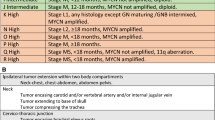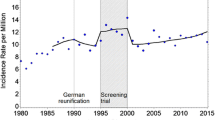Abstract
Neuroblastoma is a heterogeneous tumor and that may have a favorable or unfavorable prognosis. In Japan, a nation-wide neuroblastoma mass-screening (MS) project assessed 6-month-old infants between 1985 and 2003, and almost all neuroblastomas, including regressing or maturing tumors were thought to be detected in this period. To evaluate the heterogeneity of neuroblastoma subgroups, we analyzed patients with neuroblastoma who had been diagnosed during this period. The clinical courses of 4,209 patients with neuroblastoma, including 1,560 MS detected patients, whose tumors had been diagnosed between 1971 and 1995 were registered. The 2,520 cases registered between 1985 and 1995 were compared to 1,050 cases registered between 1971 and 1980 and analyzed by a multi-gene target model to determine the age distribution of neuroblastoma incidence. We hypothesized that three target genes were responsible for the progression of neuroblastoma: one pair of tumor suppressor gene alleles, one oncogene, and one gene controlling regression/differentiation. This simulation study revealed that the age distribution at initial diagnosis of neuroblastoma was divided into four groups based on post-fertilization age: 20–40, 40–50, 60–90, and 160–200 weeks. Since neuroblatoma in the first group occurred prenatal, post-natal clinical neuroblastoma can be classified into three age groups: 0–6 months, 1–2 years, and 3–4 years. The 0- to 6-month group consisted of mostly benign tumors, and the two older groups had predominantly malignant phenotypes. Our proposed model could explain qualitatively the distribution of neuroblastoma consisting of one subgroup with a favorable prognosis and two subgroups with unfavorable prognosis. For clinically relevant risk stratification, an age cutoff should be considered by the age distribution of these heterogeneous subgroups.






Similar content being viewed by others
References
Gurney JG, Davis S, Severson RK, Fang JY, Ross JA, Robison LL (1996) Trends in cancer incidence among children in the U.S. Cancer 78:532–541
Brodeur GM (2003) Neuroblastoma: biological insights into a clinical enigma. Nat Rev Cancer 3:203–216
Breslow N, McCann B (1971) Statistical estimation of prognosis for children with neuroblastoma. Cancer Res 31:2098–2103
Yamamoto K, Ohta S, Ito E, Hayashi Y, Asami T, Mabuchi O, Higashigawa M, Tanimura M (2002) Marginal decrease in mortality and marked increase in incidence as a result of neuroblastoma screening at 6 months of age: cohort study in seven prefectures in Japan. J Clin Oncol 20:1209–1214
Armitage P, Doll R (1954) The age distribution of cancer and a multi-stage theory of carcinogenesis. Br J Cancer 8:1–12
Moolgavkar SH (1978) The multistage theory of carcinogenesis and the age distribution of cancer in man. J Natl Cancer Inst 61:49–52
Arcana IM, Ohtaki M (2005) Multi-target models and their application to data analysis of cellular mortality due to radiation exposure. Hiroshima J Med Sci 54:9–20
Goto S, Umehara S, Gerbing RB, Stram DO, Brodeur GM, Seeger RC, Lukens JN, Matthay KK, Shimada H (2001) Histopathology (International Neuroblastoma Pathology Classification) and MYCN status in patients with peripheral neuroblastic tumors: a report from the Children’s Cancer Group. Cancer 92:2699–2708
London WB, Boni L, Simon T, Berthold F, Twist C, Schmidt ML, Castleberry RP, Matthay KK, Cohn SL, De Bernardi B (2005) The role of age in neuroblastoma risk stratification: the German, Italian, and children’s oncology group perspectives. Cancer Lett 228:257–266
London WB, Castleberry RP, Matthay KK, Look AT, Seeger RC, Shimada H, Thorner P, Brodeur G, Maris JM, Reynolds CP, Cohn SL (2005) Evidence for an age cutoff greater than 365 days for neuroblastoma risk group stratification in the Children’s Oncology Group. J Clin Oncol 23:6459–6465
Schilling FH, Spix C, Berthold F, Erttmann R, Fehse N, Hero B, Klein G, Sander J, Schwarz K, Treuner J, Zorn U, Michaelis J (2002) Neuroblastoma screening at one year of age. N Engl J Med 346:1047–1053
Kaneko Y (2007) Neuroblastomas that might benefit from mass screening at 6 months of age in Japan. Pediatr Blood Cancer 48:245–246; author reply 247
Hiyama E, Hiyama K, Yokoyama T, Ichikawa T, Matsuura Y (1992) Length of telomeric repeats in neuroblastoma: correlation with prognosis and other biological characteristics. Jpn J Cancer Res 83:159–164
Hiyama E, Hiyama K, Ohtsu K, Yamaoka H, Ichikawa T, Shay JW, Yokoyama T (1997) Telomerase activity in neuroblastoma: is it a prognostic indicator of clinical behavior? Eur J Cancer 33:1932–1936
Hiyama E, Hiyama K, Yokoyama T, Matsuura Y, Piatyszek MA, Shay JW (1995) Correlating telomerase activity levels with human neuroblastoma outcomes. Nat Med 1:249–255
Shimada H, Umehara S, Monobe Y, Hachitanda Y, Nakagawa A, Goto S, Gerbing RB, Stram DO, Lukens JN, Matthay KK (2001) International neuroblastoma pathology classification for prognostic evaluation of patients with peripheral neuroblastic tumors: a report from the Children’s Cancer Group. Cancer 92:2451–2461
Hiyama E, Hiyama K (2005) Molecular and biological heterogeneity in neuroblastoma. Curr Genomics 6:319–332
Hiyama E, Hiyama K, Ohtsu K, Yamaoka H, Fukuba I, Matsuura Y, Yokoyama T (2001) Biological characteristics of neuroblastoma with partial deletion in the short arm of chromosome 1. Med Pediatr Oncol 36:67–74
Kaneko Y, Knudson AG (2000) Mechanism and relevance of ploidy in neuroblastoma. Genes Chromosomes Cancer 29:89–95
Brodeur GM, Seeger RC, Schwab M, Varmus HE, Bishop JM (1984) Amplification of N-myc in untreated human neuroblastoma correlated with advanced stage. Science 224:1121–1124
Hiyama E, Yokoyama T, Ichikawa T, Ishii T, Hiyama K (1990) N-myc gene amplification and other prognositic associated factors in neuroblastoma. J Pediatr Surg 25:1095–1099
Schwab M, Westermann F, Hero B, Berthold F (2003) Neuroblastoma: biology and molecular and chromosomal pathology. Lancet Oncol 4:472–480
Schramm A, Schulte JH, Klein-Hitpass L, Havers W, Sieverts H, Berwanger B, Christiansen H, Warnat P, Brors B, Eils J, Eils R, Eggert A (2005) Prediction of clinical outcome and biological characterization of neuroblastoma by expression profiling. Oncogene 24:7902–7912
Hiyama E, Hiyama K, Yamaoka H, Sueda T, Reynolds CP, Yokoyama T (2004) Expression profiling of favorable and unfavorable neuroblastomas. Pediatr Surg Int 20:33–38
Schmidt ML, Lukens JN, Seeger RC, Brodeur GM, Shimada H, Gerbing RB, Stram DO, Perez C, Haase GM, Matthay KK (2000) Biologic factors determine prognosis in infants with stage IV neuroblastoma: a prospective Children’s Cancer Group study. J Clin Oncol 18:1260–1268
Evans AE, D’Angio GJ (2005) Age at diagnosis and prognosis in children with neuroblastoma. J Clin Oncol 23:6443–6444
Gotoh T, Hosoi H, Iehara T, Kuwahara Y, Osone S, Tsuchiya K, Ohira M, Nakagawara A, Kuroda H, Sugimoto T (2005) Prediction of MYCN amplification in neuroblastoma using serum DNA and real-time quantitative polymerase chain reaction. J Clin Oncol 23:5205–5210
Acknowledgments
This research was supported by Grant-in-Aid (16-Kodomo-IPPAN-012) from the Ministry of Health, Labour, and Welfare of Japan. We acknowledge Ikuko Fukuba, Yoko Chiba, Hitomi Ichikawa in N-BARD, Emi Fukuda in Department of Surgery, Graduate School of Biomedical Sciences, Hiroshima University for technical assistance. We thank the Committees on Tumor Registration, Japanese Society of Pediatric Surgeons and Japanese Society of Pediatric Oncology to providing the registered data or neuroblastoma patients. And we also thank members of the research project for evaluating the efficacy of Japanese mass-screening system in Health and Labour Science Research Grants for Research on Children and Families funded by Japanese Ministry of Health, Labour and Welfare to critical discussing of these data.
Author information
Authors and Affiliations
Corresponding author
Rights and permissions
About this article
Cite this article
Hiyama, E., Yamaoka, H., Kondo, S. et al. Heterogeneous subgroups in human neuroblastoma for clinically relevant risk stratification. Pediatr Surg Int 23, 1051–1058 (2007). https://doi.org/10.1007/s00383-007-1998-3
Accepted:
Published:
Issue Date:
DOI: https://doi.org/10.1007/s00383-007-1998-3




